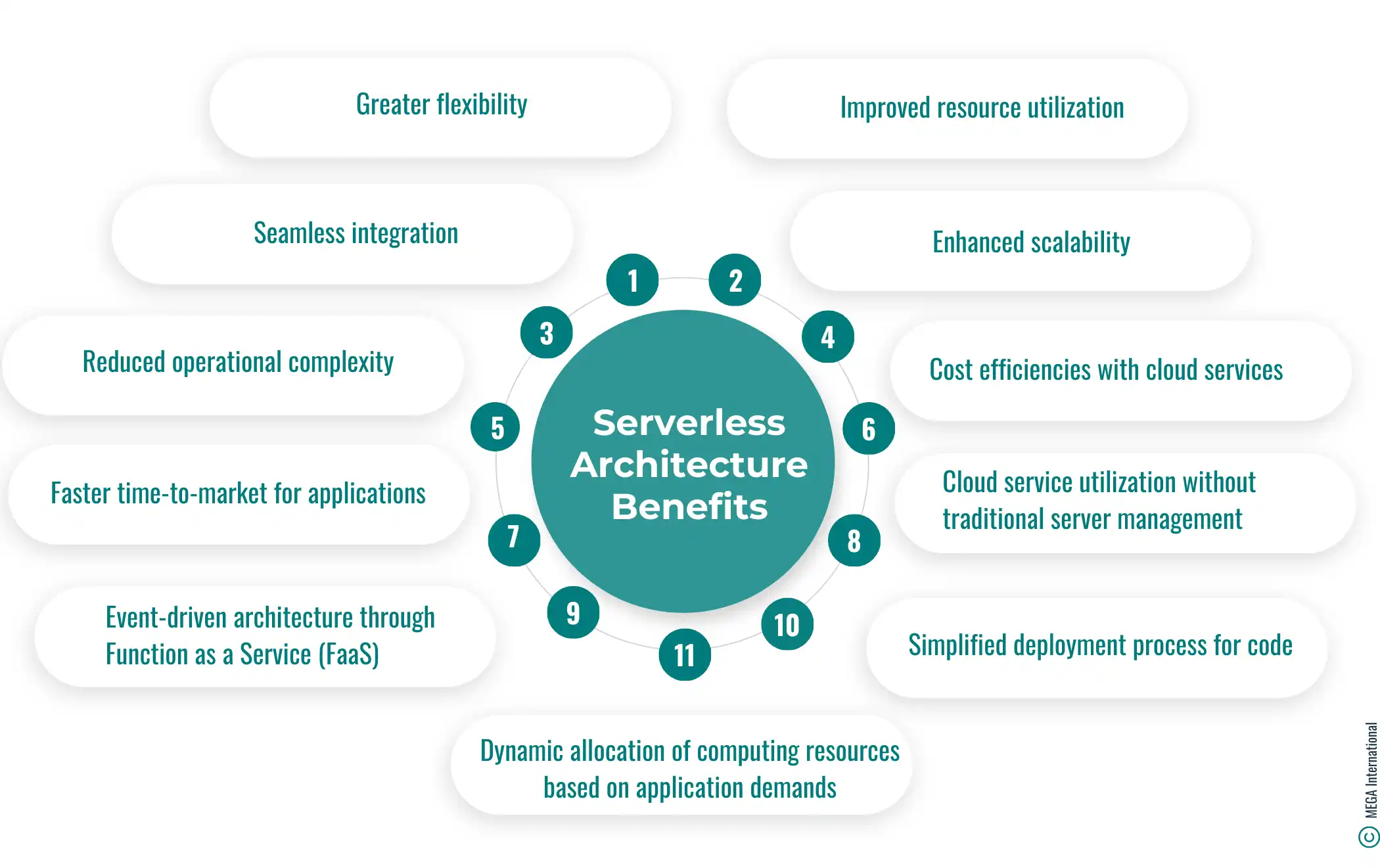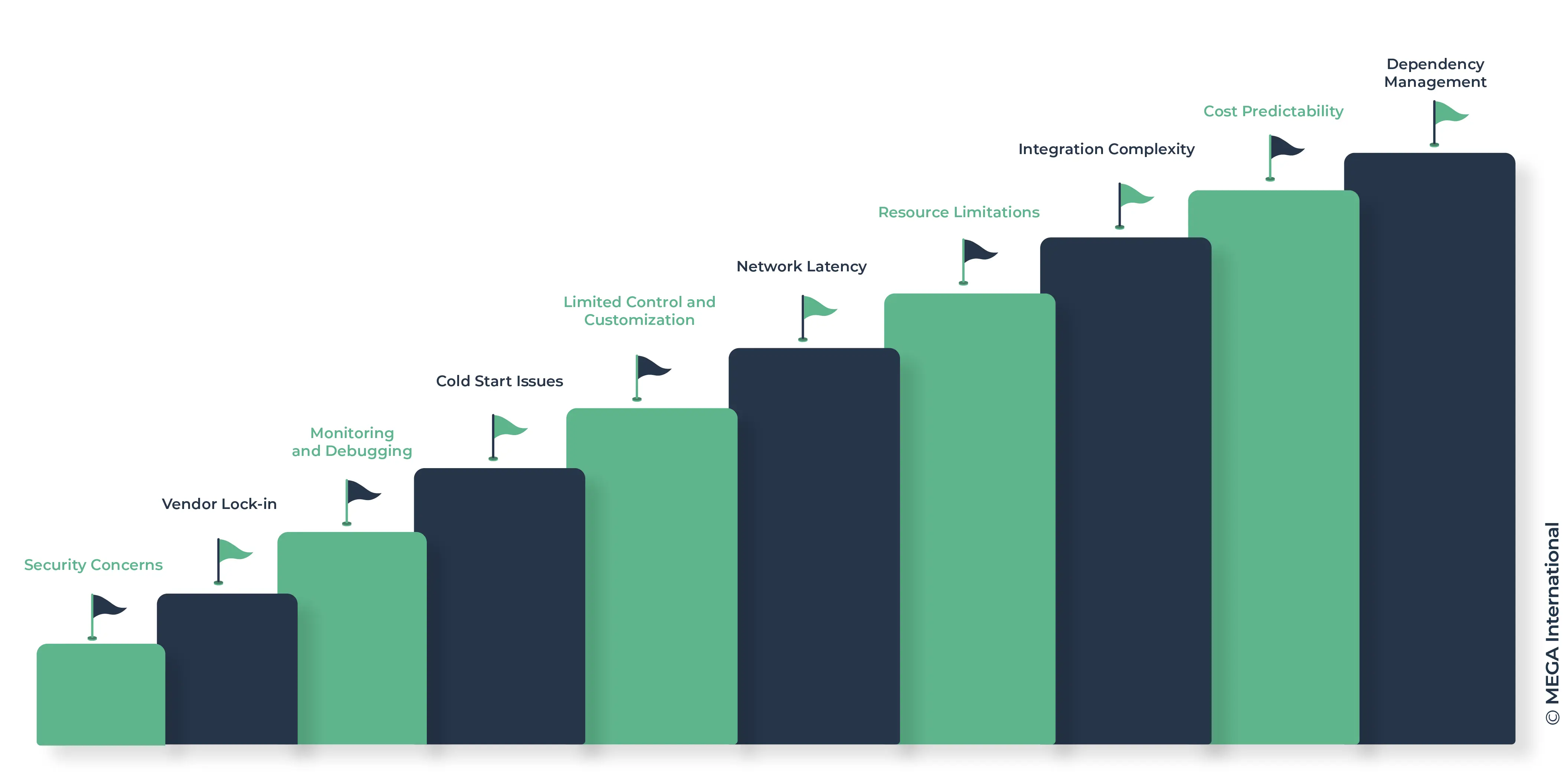
Serverless Architecture: A Beginner's Guide
Serverless architecture has been gaining significant attention in the tech industry due to its innovative approach to computing.
Serverless architecture represents a revolutionary shift in deploying and managing web applications. It's a model where the cloud provider handles servers and infrastructure, allowing developers to focus solely on writing code.
This article aims to provide an in-depth understanding of serverless architecture, its benefits, use cases, and the future outlook.
What is Serverless Architecture?
At its core, serverless computing means running applications without worrying about servers. It's not that servers are absent; they're just abstracted away from the development process.
This differs significantly from traditional server-based models, where managing and maintaining servers is a significant part of the workload.
How serverless architecture works
The serverless architecture leverages a "Function as a Service" (FaaS) model, where developers can deploy code in serverless functions.
These functions are executed in a stateless manner, triggered by specific events, and automatically scaled based on demand.
Serverless architecture fundamentally shifts the responsibility of managing servers from the developer to the cloud provider. It allows for a more agile and efficient development process by abstracting away the underlying infrastructure, enabling developers to focus solely on their code.
Benefits of serverless architecture
Serverless computing presents numerous advantages for organizations and developers alike. It allows for greater flexibility, improved resource utilization, and seamless integration.
It offers improved scalability, reduced operational complexity, and cost efficiencies with cloud services provided by AWS Lambda, Google Cloud Functions, and Azure Functions.

Additionally, it enables faster time-to-market for applications and allows developers to leverage cloud services without the need for traditional server management.
Serverless computing and FaaS
Function as a Service (FaaS) is a core component of serverless computing. It enables developers to write individual functions, which are then executed in response to specific events or triggers. This event-driven architecture is vital to the serverless paradigm.
Using serverless for deploying code
Developers can leverage serverless computing for deploying code in a highly efficient and scalable manner. With serverless platforms, the deployment process is simplified, and computing resources are allocated dynamically based on application demands.
Serverless Use Cases
Serverless architecture shines in various scenarios, such as web applications, backend APIs, and event-driven systems. It's particularly beneficial for applications with variable or unpredictable traffic.
The use cases for serverless architecture span various domains, including application development, server management, and microservices orchestration:
Get a complimentary copy: 2024 Gartner® Magic Quadrant™ for Enterprise Architecture Tools
Serverless for managing servers
Organizations can offload server management tasks to cloud providers by adopting a serverless approach, enabling them to focus on building and running applications without the burden of traditional server maintenance. This streamlined approach enhances operational efficiency.
Building and running serverless applications
Serverless architecture is well-suited for building and running applications that operate in a dynamic and distributed environment.
It allows for the seamless integration of cloud services and facilitates the efficient execution of code without the constraints of a traditional server environment.
Understanding the potential applications of serverless computing is crucial for organizations seeking to modernize their infrastructure.
Challenges of Serverless Architecture
Despite its advantages, serverless computing has scaling, operations, and orchestration challenges. Security concerns, vendor lock-in, and difficulties in debugging and monitoring are among developers' fundamental limitations.

Managing automatic scaling to meet demand while optimizing resource utilization is critical for organizations leveraging serverless platforms.
Security Concerns
In a serverless environment, the responsibility for securing the underlying infrastructure shifts to the cloud provider.
However, this doesn't eliminate all security risks. The temporary nature of serverless functions can make traditional security tools less effective, and there's an increased risk of attacks if function permissions are not correctly managed.
Vendor Lock-in
Serverless architecture often leads to a high degree of vendor lock-in. Cloud providers offer different implementation and operating models for their serverless services, making it challenging to migrate functions and services between platforms without significant modifications.
Monitoring and Debugging
Traditional monitoring and debugging tools often need to be better suited for serverless architectures.
The stateless and ephemeral nature of serverless functions can make it difficult to track issues, especially when dealing with complex, distributed applications.
Cold Start Issues
A cold start occurs when a serverless function is invoked after being idle, leading to latency in the function's execution. This can be a significant issue, especially for applications requiring consistent performance.
Limited Control and Customization
With serverless architecture, you cede much control over the environment to the cloud provider. This can limit your ability to customize the underlying infrastructure or fine-tune performance and resource allocation.
Resource Limitations
Serverless computing limits the resources available to functions, such as execution time, memory, and concurrent executions.
These limits can vary by provider and impact the suitability of serverless architecture for specific workloads.
Integration Complexity
Integrating serverless components with existing applications and services can be complex, particularly in hybrid or multi-cloud environments. This can add to the development and operational overhead.
Cost Predictability
While serverless architecture can be cost-effective, it can make costs less predictable. The pay-as-you-go model can lead to unexpected charges, especially if the application experiences sudden spikes in usage.
Dependency Management
Serverless functions often depend on external libraries and services, which can introduce dependency management, versioning, and compatibility challenges.
Network Latency
Network latency can become a bottleneck for applications requiring frequent interactions between serverless functions and other services (especially in different regions or availability zones).
State Management
Serverless functions are stateless by design, which can complicate state management in applications, requiring additional services or databases to maintain state across function invocations.
To fully embrace the power of serverless computing, it is crucial to comprehend and tackle the challenges that come with it.
These challenges play a pivotal role in determining the successful adoption of this innovative approach.
Serverless Databases and APIs
Integrating serverless databases and utilizing API gateways are integral components in building robust and scalable serverless applications.
Understanding how data storage and interaction with external systems are orchestrated within a serverless framework is essential for successful application development.
API gateways in serverless architecture
API gateways play a crucial role in serverless architecture by facilitating the interaction between serverless functions and external systems or services.
They are a centralized entry point for managing API requests and orchestrating communication across distributed functions.
Cloud service and business logic in serverless applications
Serverless applications rely on cloud services to execute business logic and process data.
Leveraging cloud service providers for functions such as data processing, authentication, and external integrations enables developers to focus on building application-specific logic without reinventing the wheel.
Best Practices in Serverless Architecture
Adopting best practices in serverless architecture is essential to maximize the benefits while mitigating potential drawbacks.
These practices optimize performance, cost, and scalability, ensuring security and maintainability. Here are some basic best practices for serverless architecture:
Design for Stateless Operations
Given that serverless functions are stateless, design your application in a way that doesn't rely on a local state. Use external services for state management when necessary, such as databases or cache services.
Implement Efficient Dependency Management
Minimize the number of dependencies in your serverless functions. This will reduce the size of your deployment package, cold start times, and potential security vulnerabilities.
Optimize Function Performance
Write efficient code to reduce execution time. This involves optimizing algorithms, reducing resource consumption, and using asynchronous processing.
Adopt a Microservices Approach
Break down your application into smaller, independently deployable functions. This microservices approach leads to easier maintenance, better scalability, and more efficient development processes.
Utilize Environment Variables
Store configuration and sensitive information in environment variables instead of hard-coding them into your functions. This enhances security and makes it easier to update configurations without changing the code.
Implement Robust Security Measures
Ensure that your serverless functions have the least privileged access they need to perform their tasks. Use identity and access management (IAM) roles and policies to control resource access.
Monitor and Log Effectively
Implement comprehensive logging and monitoring for your serverless functions. This will aid in debugging and provide insights into performance and potential issues.
Handle Cold Starts Proactively
Mitigate cold starts by keeping functions warm through regular invocations, optimizing function startup times, and considering provisioned concurrency where appropriate.
Choose the Right Trigger Types
Various events (HTTP requests, database events, queue messages, etc.) can trigger serverless functions. Choose the trigger type that best suits the function's role in your application.
Manage Costs Effectively
Monitor and analyze your serverless usage to manage costs. Be aware of your serverless provider's pricing model and optimize your function invocations to avoid unnecessary expenses.
Automate Deployment and CI/CD
Use automated and continuous integration/continuous deployment (CI/CD) pipelines. This ensures consistent and error-free deployments and facilitates rapid iteration and testing.
Design for Scalability
Architect your serverless applications with scalability in mind. This means considering concurrent executions, managing resources efficiently, and ensuring your application can handle varying loads gracefully.
Plan for Exception Handling and Retry Mechanisms
Implement proper error handling in your serverless functions. Understand and configure your functions' retry behavior to handle transient failures effectively.
Utilize API Gateways for HTTP Endpoints
Use an API gateway when exposing HTTP endpoints. This provides additional features like request throttling, authorization, and request/response transformations.
Regularly Review and Update Your Serverless Applications
Continuously review and update your serverless applications to take advantage of new features, security patches, and performance improvements provided by serverless platforms.
The Future of Serverless
The future of serverless computing holds substantial promise, given ongoing advancements in cloud computing and serverless platforms and their impact on traditional server-based systems.
Serverless computing and the future of cloud computing
Serverless computing is poised to play a pivotal role in the evolution of cloud computing, driving innovation in areas such as edge computing, seamless resource orchestration, and efficient utilization of computing resources. Its impact is set to reshape the paradigms of traditional cloud infrastructure.
Advancements in serverless platforms
Ongoing advancements in serverless platforms are focused on enhancing developer productivity, expanding the scope of serverless applications, and improving the performance of serverless functions. These advancements meet the growing demands for scalable and resilient serverless solutions.
Impacts of serverless on traditional server-based systems
The rise of serverless computing is reshaping the landscape of conventional server-based systems, leading to a shift towards more efficient resource utilization, reduced operational overhead, and increased agility in application development.
Serverless Architecture and HOPEX
Integrating Serverless Architecture, HOPEX, and Artificial Intelligence (AI) presents a dynamic and innovative landscape for modern enterprises. Each component enhances business processes, IT strategies, and overall digital transformation. Here's how these three elements can synergistically work together:
Strategic Alignment with AI Initiatives
HOPEX, known for its enterprise architecture (EA) and governance capabilities, can help organizations strategically align their serverless and AI initiatives. Adopting AI technologies in a serverless environment aligns with broader business goals and IT strategies.
Facilitating AI Model Deployment with Serverless Architecture
Serverless architecture provides a scalable and cost-effective environment for deploying AI models. HOPEX can assist in planning and documenting the architecture of these deployments, ensuring they are well-integrated within the organization's existing IT infrastructure and align with enterprise standards.
Governance and Compliance in AI Implementations
Managing governance and compliance becomes crucial as AI applications grow in complexity and scope. HOPEX can provide the framework for ensuring that AI implementations in a serverless environment adhere to regulatory standards and internal policies, particularly around data privacy and ethical AI use.
Risk Management in AI and Serverless Environments
Both AI and serverless architectures introduce unique risks. HOPEX can aid in identifying, assessing, and mitigating these risks. This includes managing the security risks inherent in serverless environments and the potential biases or inaccuracies in AI models.

READ: What is Risk Management
- Enhancing Data Management for AI: AI systems rely heavily on data. Serverless architecture can facilitate the processing and analysis of large data sets in real-time, which is crucial for AI applications. HOPEX can assist in the architecture and governance of data management processes, ensuring data quality and accessibility for AI systems.
- Supporting Innovation and Rapid Development: The combination of serverless architecture and AI fosters an environment of innovation and rapid development. HOPEX can support this by providing a framework for managing these rapid changes, ensuring they align with the organization's strategic objectives.
- Integrating AI into Business Processes: HOPEX can help map how AI capabilities, deployed in a serverless environment, blend into and enhance existing business processes. This could involve automating tasks, improving decision-making processes, or creating new customer experiences.
- Vendor and Technology Management: Organizations may rely on various vendors and technologies when deploying AI solutions in a serverless architecture. HOPEX can facilitate effective vendor management and technology selection, ensuring they align with the enterprise's needs and standards.
- Building a Scalable AI Architecture: Serverless architecture allows for the scalable deployment of AI models. HOPEX can assist in designing an architecture that scales efficiently as AI
The Future of Serverless Architecture and AI
The intersection of serverless architecture and artificial intelligence (AI) is an area ripe for innovation and significant advancements in the coming years. As both technologies mature, their integration is expected to transform how AI applications are developed, deployed, and scaled.
Here are some key trends and predictions for the future of serverless architecture in the realm of AI:
Seamless AI Model Deployment
The serverless architecture will simplify the deployment of AI models by abstracting away much of the infrastructure management. This means AI developers can focus more on model development and less on the complexities of scaling and maintaining the underlying infrastructure.
Cost-Effective AI Solutions
The pay-as-you-go pricing model of serverless computing aligns well with the variable workload patterns typical in AI applications, making it a cost-effective solution for AI development. This could democratize AI, making advanced AI technologies more accessible to smaller businesses and startups.
Real-Time AI Processing
Serverless architecture can facilitate real-time AI processing by instantly providing the necessary computational resources and scaling them according to the workload. This is particularly beneficial for applications requiring immediate AI-driven insights, such as fraud detection, real-time analytics, and personalization engines.
Enhanced AI Development Tools and Ecosystems
As serverless computing grows in AI, we can expect more specialized tools and ecosystems to emerge. These tools will likely offer enhanced functionalities for AI model training, versioning, and monitoring tailored to serverless environments.
Scalability for Machine Learning Workloads
Serverless architecture can provide the dynamic scalability needed for machine learning workloads, especially for training and inference phases. It can automatically adjust resources based on the computational needs of these tasks.
Edge AI and Serverless
The combination of edge computing and serverless architecture will boost Edge AI applications. By running AI models on edge devices in a serverless manner, lower latency, reduced data transfer costs, and data processing closer to the source can be achieved.
Increased Focus on AI Security in Serverless Environments
As AI applications become more prevalent in serverless environments, a growing focus will be on specific security measures for AI systems.
This includes protecting AI models from tampering, ensuring data privacy, and securing AI-driven workflows.
Integration with IoT and Big Data
Serverless architecture will likely play a key role in processing data from IoT devices and big data platforms for AI applications.
This integration will enable more efficient data processing workflows, where AI models can be applied to vast datasets in real-time or near real-time.
Auto-Scaling AI Workflows
With serverless architecture, AI workflows can be designed to scale automatically based on demand. This is particularly useful for handling unpredictable or cyclical AI workloads without manual intervention.
Customizable AI Environments in Serverless Architecture
Future developments may include more customizable serverless environments optimized for specific AI tasks, such as deep learning, natural language processing, or computer vision.
Collaborative AI Development
Serverless architecture can facilitate collaborative AI development by providing a shared, scalable platform where developers can work together on AI models regardless of their physical location.
FAQs
Serverless architecture is a way of building and running applications without managing server infrastructure. It allows developers to focus on writing code and deploying serverless services without managing server hardware or operating systems.
Serverless architecture offers a serverless computing model where the cloud provider handles the underlying infrastructure. This allows developers to build and run serverless apps without worrying about managing virtual machines or physical servers.
In traditional server-based architecture, developers manage the servers and infrastructure. When using a serverless architecture, the cloud vendor (like AWS or IBM Cloud) manages the server operation, allowing developers to focus solely on building and deploying their applications.
The central concept behind serverless computing is that developers can write code and deploy applications without managing the underlying server infrastructure. It enables them to run their applications seamlessly using the public cloud or a cloud platform.
Serverless architecture allows developers to build and deploy serverless apps without managing the underlying servers. This frees them from the burden of managing server hardware, operating systems, and server infrastructure, enabling a more streamlined development process.
Cloud vendors like AWS, Microsoft Azure, and Google Cloud Platform provide serverless computing services. These platforms enable developers to leverage the benefits of serverless architecture for their applications.
Yes, serverless architecture can be used for various applications, from simple microservices and APIs to complex event-driven architectures. It provides developers a flexible and scalable environment for deploying their applications without managing servers.
Serverless architecture automatically handles scalability and resource management for applications. The cloud provider manages the allocation of resources based on application demand, ensuring that developers do not need to worry about scaling their infrastructure.
Yes, serverless architecture can lead to cost savings for businesses as it eliminates the need to manage and maintain server hardware, which can be a significant expense. It also allows for more efficient resource allocation, reducing operational costs for running applications.
The critical components of serverless architecture include serverless application models, serverless computer services, event-driven architecture, and managed services. These components together form the foundation for building and deploying applications in a serverless environment.
The value of Enterprise Architecture to accelerate business transformation

Access this white paper to learn:
- The evolution of the enterprise architecture practice
- How to Deliver Value through a Connected Enterprise Architecture Practice
- Strategies for Adopting a Business-Outcome-Driven Approach
- How to Use Data-Driven Tools to Enhance Your Enterprise Architecture Connectivity
Enterprise Architecture Related Content
Shift from a documentation tool to an operational tool and accelerate business transformation
MEGA HOPEX for Enterprise Architecture
Request a demonstration of HOPEX for EA, and see how you can have immediate value of your projects.















